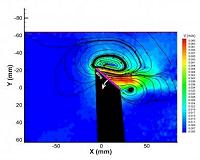| . |  |
. |
London, UK (SPX) Nov 22, 2010 Like gangsters running a protection racket, drongos in the Kalahari Desert act as lookouts for other birds in order to steal a cut of their food catch. The behaviour, revealed in research funded by BBSRC published in Evolution and reported in Nature's Research Highlights, may represent a rare example of two species evolving from a parasitic to a mutualistic relationship. The team from the Universities of Bristol, Cambridge and Cape Town showed that victimised pied babblers gained a mitigating benefit from the presence of thieving drongos because, by keeping watch for predators, the drongos allowed the babblers to focus on foraging and so catch more insects. Many apparently harmful parasites seem to be tolerated by their hosts and the provision of compensatory benefits to victims could underpin a range of host-parasite relationships. The insight the research provides into complex co-evolution between species gives scientists a valuable way of understanding other important relationships, such as those between drugs and bacteria and between pathogens and hosts. Dr Andrew Radford, who led the research funded through a BBSRC David Phillips Fellowship, said: "Because drongos are parasitic birds who swoop in to steal food from other species, you'd expect them to keep a low profile while waiting. Rather surprisingly, however, drongos perched above foraging babblers advertise their presence by issuing a call called a 'twank' every 4 or 5 seconds. "When we played back these 'twank' calls to a babbler group, we found that they spread out over a larger area and lifted their heads less often, indicating that they were less fearful of predators when they thought a drongo was keeping watch. We think that drongos have evolved to alert babblers to their presence because helping the group forage more effectively leads to more frequent opportunities for theft." Drongos have an ingenious way of catching food: by crying wolf about the presence of predators, they scare other animals into dropping their catch, which the birds then pounce on. This research indicates that pied babblers have evolved to tolerate the drongos giving false warnings and stealing some of their hard-earned gains in exchange for the chance to forage in relative safety when a drongo is keeping watch. Dr Radford continued: "Like any good gangster, as well as lying and stealing, the drongos also provide protection by mobbing aerial predators and giving true alarm calls on some occasions. But, despite all of the useful services drongos provide, the foraging birds are still more responsive to calls from other babblers. It seems likely that the babblers simply don't trust the drongo mafia as much as their own flesh and blood." Professor Douglas Kell, BBSRC Chief Executive said: "Evolutionary arms-races, including those between parasites and their hosts, and plants and animals and the diseases that they suffer, underlie a whole range of socially and economically important areas of biology. "From drug and pesticide resistance to the biodiversity of ecosystems, deepening our understanding how a range of organisms have evolved into complex relationships will help us address important social issues in a smarter, more holistic way." The research was carried out with the support of the Percy FitzPatrick Institute of African Ornithology at the University of Cape Town, Magdalene College, Cambridge, and the EU.
Share This Article With Planet Earth
Related Links BBSRC Darwin Today At TerraDaily.com
 How Hummingbirds Fight The Wind
How Hummingbirds Fight The WindWashington DC (SPX) Nov 22, 2010 Hummingbirds rank among the world's largest and most accomplished hovering animals, but how do they manage it in gusty winds? A team of researchers at New Mexico State University, Los Alamos National Laboratory, Technische Universiteit Eindhoven, and Continuum Dynamics Inc. has built a robotic hummingbird wing to discover the answer, which they describe at the American Physical Society Div ... read more |
|
| The content herein, unless otherwise known to be public domain, are Copyright 1995-2010 - SpaceDaily. AFP and UPI Wire Stories are copyright Agence France-Presse and United Press International. ESA Portal Reports are copyright European Space Agency. All NASA sourced material is public domain. Additional copyrights may apply in whole or part to other bona fide parties. Advertising does not imply endorsement,agreement or approval of any opinions, statements or information provided by SpaceDaily on any Web page published or hosted by SpaceDaily. Privacy Statement |